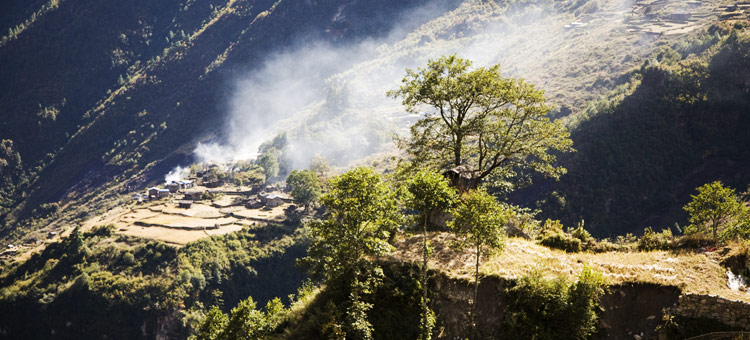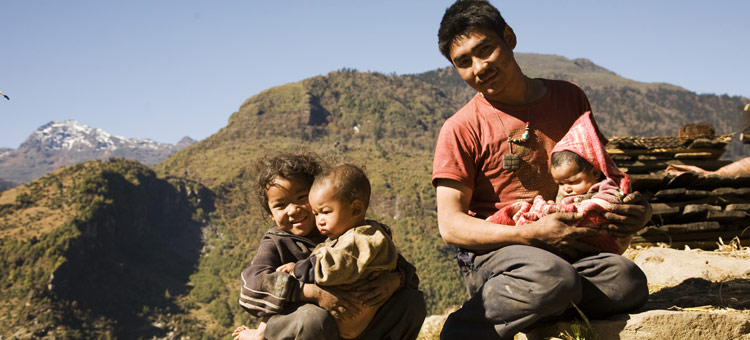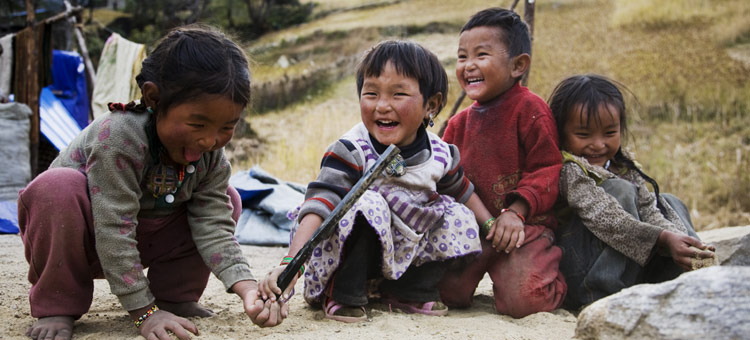The caste system of Sherpa living within China and Nepalese have the same strain in the past. Modern Sherpa have been living locally for more than 260 years. Their ancestors however were from Xiaer Kongbu of Nepal. It is also said that they came from Ganzi Tibetan Autonomous Prefecture in Sichuan Province. When they first meet, Sherpa people will ask each other's caste first. If they have the same caste they cannot joke with one another, nor can they marry.

Sherpa village hidden among the hills.[Photo/Xinhua]
Sherpa, Tibetans, and other ethnic groups could not intermarry in the past. Sherpas withdifferent castes in Nepal however, are not subject to national and geographic constraints and can intermarry. There are several different ways they can marry. First, one man can invite someone to go to a girl's house with him to speak with her parents and bring them wine and a khada. If the girl's family agrees, they will invite him to eat with them and then he can marry their daughter. The second way for a man to acquire a wife is to gain her parent's agreement first. If the girl herself does not agree the suitor can "grab" his bride and marry her thereafter. The third way a marriage to occur is if both the girl and the boy agree While the girl's parents disagree, the boy can grab the woman and hide her in the mountains. The parents will then have to agree to their marriage before the girl is brought home. Before marriage it is also customary for the boy to give a dowry to the bride's family line.
Sherpa also have a form of marriage between two brothers with the same wife. The wife will have her own housing that is equipped with twin beds. The two brothers will each have their own housing. Who is with the wife at a given time is decided by either the two brothers together or by the wife. If there are four brothers there are customs of pairing the two elder brothers with one wife and the two younger brothers with another wife. Weddings between two grooms and a bride will all have the same ceremony. But this practice between Tibetans and the Menpa ethnic group differ in some aspects.

Sherpa people at the top of a mountain.[Photo/Xinhua]
Trail marriage
When a Sheerba girl becomes 14 years old her parents let her go out on her own to make friends. She also has a small room for herself. Daughter of wealthy family will have her own small wooden buildingwhere she will live alone at night. When she chooses a boyfriend she can take him home secretly to her room. Even if the parents know they will not interfere butteach her about sex. If they have lived some time together and are happy with one another, the man will entrust a matchmaker to go speak to the girl's parents. He will also send along a few bowls of rice wine to the girl's home. This is how the formal engagement will be created.
After this engagement, the fiancé can openly live with the girl. If either is not satisfied during this period, the man will have to immediately leave the woman's small wooden building. However, most men and women can successfully advance to the next stage, which is having a baby. After they have the baby, the man and woman will be announced as having a subordinate relationship to one another. Then the man can formally introduce her to his parents to marry. If the relationship between the two is falling apart, after consultation the husband can pay the wife to raise the child which will be left with her, or can take the children away. If they continue dating, they can establish a partner relationship. Then she will take the children and move in with her husband's family. Then they will have a grand wedding.
According to Puerba, a Sheerba caste youth, "In general, when a girl is 14 years old and a boy is 16 years old they can live together. But after a time, it is important to reconsider if you should form a family. This generally takes three to ten years". An old Sheerba grandmother Sangzhuma explained, "The reason is very simple: for men and women there is no better way to understand one another than in bed. Even just sleeping in bed, it is not that easy to understand one another and communicate. So a trail marriage before an official one or having a baby will help them to build trust and experiences on how to share responsibilities together in the future life.

Lovely Sherpa children.[Photo/Xinhua]
